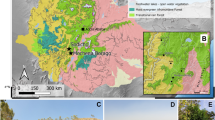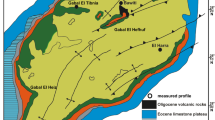Abstract
Archaeological charcoals from Puritjarra rock shelter provide the first direct information about the vegetation of central Australia during the late Pleistocene and early Holocene. During the late Pleistocene there appears to have been a more open vegetation than today with fewer trees and shrubs, though with many of the taxa that are important in the modern central Australian flora. The persistence of species such as Acacia macdonnelliensis, Callitris glaucophylla and Eucalyptus opaca throughout the time of the last glacial maximum and the presence of appreciable quantities of wood charcoal in the archaeological deposits at this time indicate that the region was not a tree-less steppe even during full glacial aridity. From 13,000 B.P. onwards, acacias are strongly represented in the charcoal assemblage both quantitatively and in terms of the number of species present. Acacia aneura is for the first time a major component of the assemblage indicating that it had by this time become a significant element of the local vegetation. These changes coincide with evidence elsewhere in the Australian arid zone for the onset of wetter conditions in the early Holocene.
Similar content being viewed by others
References
Bowdery D (1989) Phytolith analysis: Introduction and applications. In: Beck W, Clarke A, Head L (eds) Plants in Australian Archaeology. Tempus 1. Anthropology Museum, University of Queensland, Brisbane, pp 161–96
Bowler JM, Huang Q, Chen K, Head MJ, Yuan B (1986) Radiocarbon dating of playa lake hydrologic changes: examples from northwestern China and central Australia. Palaeogeogr Palaeoclimatol Palaeoecol 54: 241–60
Boyd WE (1988) Methodological problems in the analysis of fossil non-artifactual wood assemblages from archaeological sites. J Archaeol Sci 15: 603–19
Cubis L (1980) Hubble, bubble, toil and trouble? Dealing with plant remains in Australian archaeological sites. In: Johnson I (ed) Holier Than Thou: Proceedings of the 1978 Kioloa Conference on Australian Prehistory, Department of Prehistory, Research School of Pacific Studies, The Australian National University, Canberra
Deacon HJ, Deacon J, Scholtz A, Thackeray JF, Brink JS, Vogel JC (1983) Correlation of palaeoenvironmental data from Late Pleistocene and Holocene deposits at Boomplaas Cave, Southern Cape. In: Vogel JC (ed) Late Cainozoic Palaeoclimates of the Southern Hemisphere. Balkema, Rotterdam pp 339–52
Donoghue D (1989) Carbonised plant macrofossils. In: Beck W, Clarke A, Head L (eds) Plants in Australian Archaeology. Tempus 1. Anthropology Museum, University of Queensland, Brisbane, pp 90–110
February E (1992.) Archaeological charcoals as indicators of vegetation change and human fuel choice in the late Holocene at Elands Bay, Western Cape Province, South Africa. J Archaeol Sci 19: 347–54
Gillespie R, Magee JW, Luly JG, Dlugokencky E, Sparks RJ, Wallace G (1991) AMS radiocarbon dating in the study of arid environments: Examples from Lake Eyre, South Australia. Palaeogeogr Palaeoclimatol Palaeoecol 84: 333–8
Hopkins MS, Graham AW, Hewett R, Ash J, Head MJ (1990) Evidence of late Pleistocene fires and eucalypt forest from a north Queensland humid tropical rainforest site. Austral J Ecol 15: 345–47
Jackson EA (1962) Soil studies in central Australia: Alice Springs-Hermannsburg-Rodinga Areas. Commonwealth Scientific and Industrial Research Organisation. Melbourne, Soil Publication No. 19
Jessop J (ed) (1981) Flora of central Australia. The Australian Systematic Botany Society and Reed Books, Sydney
Leney L, Casteel RW (1975) Simplified procedure for examining charcoal specimens for identification. J Archaeol Sci 2: 153–9
McGinnes EA, Szopa PS, Phelps JE (1974) Use of scanning electron microscopy in studies of wood charcoal formation. Scanning Electron Microscopy 1974; 469–76
Nix HA, Austin MP (1973) Mulga: a bioclimatic analysis. Tropical Grasslands 7: 9–21
Perry RA (1962) (ed) Lands of the Alice Springs area, Northern Territory, 1956–57. Commonwealth Scientific and Industrial Research Organisation, Melbourne
Perry RA. Lazarides M (1962) Vegetation of the Alice Springs area. In: Perry RA (ed) Lands of the Alice Springs area, Northern Territory, 1956–57. Commonwealth Scientific and Industrial Research Organisation, Melbourne, pp 208–236
Shackleton CM, Prins F (1992) Charcoal analysis and the „Principle of Least Effort“ — A conceptual model. J Archaeol Sci 19: 631–7
Singh G (1981) Late Quaternary pollen records and seasonal palaeoclimates of Lake Frome, South Australia. Hydrobiologia 82: 419–430
Singh G, Luly J (1991) Changes in vegetation and seasonal climate since the last full glacial at Lake Frome, South Australia. Palaeogeogr Palaeoclimatol Palaeoecol 84: 75–86
Smart LS, Hoffman ES (1988) Environmental interpretations of archaeological charcoal. In: Hastorf CA, Popper, VS (eds) Current Paleoethnobotany: analytical methods and cultural interpretations of archaeological plant remains. University of Chicago Press, Chicago, pp 167–205
Smith MA (1987) Pleistocene occupation in arid central Australia. Nature 328: 710–711
Smith MA (1988) The pattern and timing of prehistoric settlement in central Australia. unpublished PhD thesis, Department of Prehistory and Archaeology, University of New England, Armidale NSW
Smith MA (1989) The case for a resident human population in the central Australian ranges during full glacial aridity. Archaeology in Oceania 24: 93–105
Smith MA, Vellen L, Pask J (in press) SEM photomicrographs of central Australian wood charcoals: A guide to the identification of archaeological and fossil charcoals. Research Papers in Archaeology. Division of Archaeology and Natural History, Research School of Pacific and Asian Studies, The Australian National University, Canberra
Veth P (1989) Islands in the interior: A model for the colonisation of Australia's arid zone. Archaeology in Oceania 24: 81–92
Author information
Authors and Affiliations
Rights and permissions
About this article
Cite this article
Smith, M.A., Vellen, L. & Pask, J. Vegetation history from archaeological charcoals in central Australia: The late Quaternary record from Puritjarra rock shelter. Veget Hist Archaebot 4, 171–177 (1995). https://doi.org/10.1007/BF00203935
Received:
Accepted:
Issue Date:
DOI: https://doi.org/10.1007/BF00203935




